This is a Voigtländer Prominent 35mm rangefinder camera made by Voigtländer AG Braunschweig between the years 1952 and 1958. At the time of it’s release, it was Voigtländer’s top of the line 35mm camera and was designed to compete with Ernst Leitz’s Leica series. It has an interchangeable bayonet lens mount, a coincident image coupled rangefinder, a reliable Synchro Compur leaf shutter, and had available to it a large selection of excellent lenses such as the 7-element 50mm f/1.5 Nokton and the monstrous 24mm f/5.8 Ultragon. In addition to lenses, a whole system of auxiliary viewfinders, a reflex finder, and many other accessories were available for it making it a viable option for professional photographers. The Prominent remains one of the most unique and beautifully constructed 35mm cameras ever made and is still highly collectible today.
Film Type: 135 (35mm)
Lens: 50mm f/2 Voigtländer Ultron coated 6-elements
Lens Mount: Prominent Bayonet Mount
Focus: 3.3 feet to Infinity
Viewfinder: Coincident Image Coupled Rangefinder
Shutter: Synchro Compur MXV Leaf
Speeds: B, 1 – 1/500 seconds
Exposure Meter: None
Battery: None
Flash Mount: Coldshoe and M and X Flash Sync
Weight: 884 grams
Manual: http://www.cameramanuals.org/voigtlander_pdf/voigtlander_prominent_i.pdf
Manual (alternative): https://www.pacificrimcamera.com/rl/00600/00600.pdf
How these ratings work |
The Voigtländer Prominent was created as a system camera for professional photographers. Featuring an interchangeable bayonet lens mount with a number of optically excellent lenses and accessories available to it, upon it’s release it represented the finest of the German camera industry. Despite this high praise, within two years of it’s release, it was quickly overshadowed by the Leica M3 and several different 35mm rangefinders being produced in Japan. The camera has several design characteristics which were not shared by other manufacturers, making the use of the Prominent unlike any other camera. For a collector looking for a well built camera that’s NOT a Leica, this is the camera for you. For the rest of the world though, the Prominent remains a curiosity in the history of cameras. A fine built camera with great lenses, that’s just not a whole lot of fun to use. | ||||||
| Images | Handling | Features | Viewfinder | Feel & Beauty | History | Age | |
| 2 | 0 | 1 | 1 | 2 | 1 | 30% | |
| Bonus | none | ||||||
| Final Score | 9.1 | ||||||
History
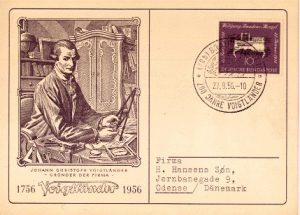
Voigtländer was founded by Johann Christoph Voigtländer in Vienna, Austria in 1756. While ownership of the company has shuffled and been reorganized a couple of different times over the years, the Voigtländer brand is not only the world’s oldest optics brand, it is one of the oldest brands in any industry in the whole world.
In the 18th century, Voigtländer was a maker of scientific instruments and navigational tools like compasses and astrolabes. Voigtländer held state-owned patents from the Austrian government which granted them exclusive rights to produce these instruments, so its likely they were the only company making them.
Johann Christoph Voigtländer would die in 1797 and the company would pass onto his widow and three sons. In the early 19th century, the company would expand it’s product portfolio to include early optical instruments. In my research for this article, I could not find many specific references to what Voigtländer made in the early 1800s, but my guess would be military or naval type products like scopes or binoculars, or perhaps even eye glasses. I found some information saying that in 1823, they made opera binoculars.
Voigtländer’s earliest photographic products seemed to start around the year 1840 when they introduced the first optical lens designed using a modern understanding of mathematics and the physics of light. This first lens was called the Petzval lens and was designed by Hungarian Professor Jozef Maximilián Petzval. Prior lenses to the Petzval were just curved pieces of glass with little to no thought put into the physics of how light would pass through them.
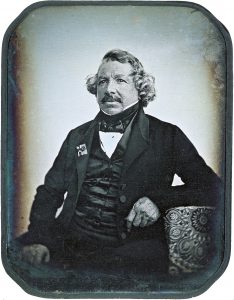
Disclaimer: In an effort to not get too far off topic for this review, I will do my best to type a very short summary of the earliest days of photography. This is a topic that spans nearly a century and could fill many chapters of a book. I will gloss over many aspects of these earliest days, so please excuse me if I leave a lot out! 🙂
One of the first types of photography was called the ‘daguerreotype‘ which was invented in the 1830s by French inventor, Louis-Jacques-Mandé Daguerre. The process of making a daguerreotype starts with a silver-plated copper plate. That plate is first buffed and polished until it looks like a mirror. Then the plate is sensitized to light over iodine and bromine in specialized, light-proof boxes. These early boxes didn’t have lenses in the traditional sense. Many used pinholes where a very small hole was drilled into a piece of metal or wood that would use refractive properties of light to make an image on the light sensitive plate. The earliest glass lenses were still very small with very small apertures that would let very little light in.
A typical daguerreotype image would take many minutes to capture as it took a great deal of time for the image to be exposed by the reflective surface of the plate. As a result, the earliest photographic images were typically still lifes or landscapes. For a person’s portrait to be captured, they would need to sit still for a very long time, sometimes as long as 10 minutes without moving. Early daguerreotype portraits were taken with people sitting in specialized chairs with braces that would hold their head, neck, and arms in a fixed position for the necessary amount of time.
The Petzval lens was significant because it’s aperture was around the modern equivalent of f/3.7 which meant that it could let in a great deal more light than the pinhole lenses previously used. This meant that an image could be captured in as little as 30 seconds instead of 10 minutes, making it much easier to capture someone’s portrait.
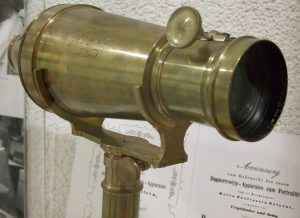
Voigtländer’s first camera was an all-metal daguerreotype released in 1841 called the Daguerreotyp-Apparat zum Portraitiren. This camera was made of brass and was shaped somewhat like a bowling pin. There was a fat end where the lens resided, and a thinner end with a ground glass focusing screen and a magnifying eye piece that the photographer would use to get the image in focus. These early cameras did not have any type of shutter. A lens cap was manually placed over the end of the tube to prevent light from entering the camera. Once the photographer had his image composed and in focus, he would put the lens cap back on, cover the camera using a box or a dark cloth, and remove the back section that contained the ground glass and eyepiece. He or she would replace this part with a traditional daguerreotype plate and then would remove the lens cap for whatever length of time was needed to expose the image. Upon completion of the exposure, the lens cap would be placed back on the front of the camera, and the entire apparatus would be moved into a dark room, where the plate would be removed and developed. As primitive and complicated as this sounds today, this was groundbreaking stuff back then. Prior to these early daguerreotypes, the only way we could capture an image was by paint.
Over the course of the next 2 decades, Voigtländer would continue to be the world leader in photographic lens manufacturing. In 1862, the company would produce it’s 10,000th Petzval lens. I could not find any indication of how much competition they had around the world at this time, but my guess is, there wasn’t much. The daguerreotype would remain the dominant form of photography during this time, but would eventually fall out of favor to two other methods, known as ambrotypes, and tintypes. Each of these methods used glass and tin respectively and were developed using different chemicals. While the concept of an ambrotype and tintype was similar to that of a daguerreotype, they weren’t the same thing. Glass and tin plate cameras would remain popular until the 1880s when the Eastman-Kodak company would invent the concept of photographic film.
In 1868, Voigtländer’s company headquarters would relocate from it’s original location in Vienna, Austria to Braunschweig, Germany where the company would remain until at least the end of World War II.
Although Voigtländer had success with their early metal daguerreotypes, their primary success came from continued production of their Petzval lenses which were used by a variety of camera makers. Even after the daguerreotype was superseded by newer technologies, the Petzval remained a popular choice for portraiture photography.
Voigtländer wouldn’t release another camera until around 1890 (some sources state it was after 1900), when they would release a Reisekamera which is a generic name meaning “travel camera” in German. Many manufacturers made similar style cameras and it can be extremely difficult to identify who made a particular Reisekamera because the parts were wooden, modular, and lacked any unique differences between all the companies making them at the time. So while it is possible Voigtländer had a variety of these style of cameras, it’s almost impossible now to identify them as an actual Voigtländer model.
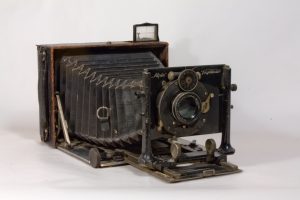
As film photography would gain momentum in the 1900s with models from The Eastman Kodak company and other German makers, Voigtländer would eventually make a more serious effort into designing their own cameras. In the first two decades of the 20th century, the company would release a wide range of folding plate cameras with names such as Scheren-Camera, Alpin, Stereophotoskop, and Avus. Also around this time, Voigtländer would begin to experiment with new, more advanced lens designs which would be called the Heliar, Dynar, and Kollinear lenses. Each of these lenses would be predecessors to the Skopar and Color-Spokar lenses which would be extremely successful later in the 20th century.
Voigtländer had great success around this time as both a maker of fine plate cameras and lenses. In 1915, the company would outgrow it’s original factory in Braunschweig and would move to a larger facility on the other side of the town. When the first World War broke out, Voigtländer would make military products for the German war effort.
After the war however, the company struggled due to the collapse of the German economy. Several key employees would leave the company such as Paul Franke and Rudolf Heidecke who would form their own company Franke & Heidecke, who would later be known as Rollei and would become one of the premiere German camera makers of the 20th century.
Things would stabilize around 1925 when Voigtländer would be acquired by German chemicals company, Schering AG. By 1929, the company would see great success making more consumer oriented roll film models such as the original Bessa. The Bessa name would be the company’s most successful line of cameras starting as 6×9 folding roll film cameras, and evolving over the next 80 plus years into a digital camera which is still sold today.
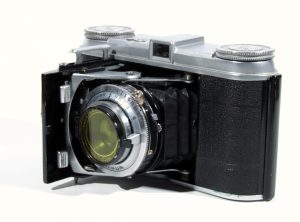
Throughout most of the 1930s, Voigtländer would mainly stick to medium format roll film cameras like the Bessa, the Perkeo, and the Inos. The company would be one of the last German companies to release a ‘miniature’ camera using the new 35mm format which was popularized by Leitz, Zeiss-Ikon, and Kodak. Many other German camera makers such as Balda, Welta, and Ciro would all have competing 35mm models before Voigtländer’s first 35mm model, the Vito which was released in 1939. The first Vito was designed for unperforated 35mm cinema film and made 30mm x 40mm exposures. This original Vito was made only for a short while in 1939 and early 1940 until production was halted due to the start of World War II.
Voigtländer’s location in Braunschweig meant that it would fall under the Allied control of West Germany after the war. This proved to be beneficial as it allowed them to more quickly get back to making cameras.
It would seem that the company’s priorities changed after the war as most new models were designed for 35mm film. The pre war Voigtländer Superb and Rollfilm models were discontinued and the only medium format cameras still made were the Bessa and Perkeo series. The Vito, Vitessa, and Prominent series cameras represented the entry, mid, and pro level cameras in the 35mm segment.
Released in 1952 (some sites incorrectly state 1950), the Prominent was the company’s most ambitious 35mm camera to date. It featured an all-new interchangeable bayonet lens mount, a combined coincident image rangefinder, fully synchronized Syncho-Compur leaf shutter, self timer, coupled film transport, double image prevention, the ability to change films mid roll, and an available list of lenses and accessories. The Prominent was viewed as a “System” camera, much like the Leica and Exakta cameras were.
Below is the “Prominent and it’s System” catalog from January 1957 with an introduction to the camera and a list of every lens and accessory available at the time.
If you’d like to see more, here are links to two more Prominent catalogs courtesy of Pacific Rim Camera, the first from February 1952, and the second from June 1954.
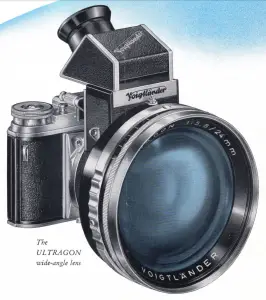
Voigtländer was no stranger to making quality lenses, and for the Prominent, they made available some of their best formulas. The base 50mm lens was either a f/2.8 Color Skopar, the f/2 Ultron, or their top of the line f/1.5 Nokton. There was a 100mm Telomar, and eventually a 35mm f/3.5 Skoparon. Made in extremely limited quantities was a very expensive wide angle called the Ultragon. This lens had a 24mm focal length and f/5.8 maximum aperture and worked with an auxiliary reflex housing. The lens might seem slow today, but lenses wider than 35mm back then were incredibly rare. There was a 100mm Telomar, and eventually a 35mm f/3.5 Skoparon.
Compared to the Leica and the Contax, the biggest selling point of the Prominent was the Synchro-Compur shutter’s ability to synchronize flash at all speeds. Focal plane shutters like the Prominent’s German competition can only synchronize with electronic flashes at speeds between 1/25th and 1/60th of a second. The Prominent could do it at it’s fastest speed of 1/500, meaning that you could easily capture a fast moving object in poor lighting.
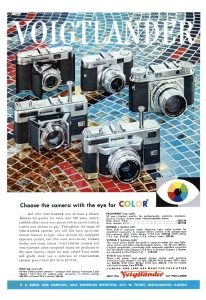
On paper, the Prominent had everything it should have needed to succeed. Made by a highly regarded German manufacturer with some of the best lenses money could buy, a solid build quality and a decent selection of accessories for the professional. It’s price compared to other precision rangefinders at $229.50 and $279.50 with the Ultron f/2 and Nokton f/1.5 lens respectively, but it didn’t sell that well. Towards the end of it’s production, the Prominent would be revised to include a film advance lever, instead of a knob, but was otherwise the same.
Perhaps the world was already starting to embrace the Single Lens Reflex style of camera by the peak of the Prominent’s popularity, perhaps it was the market dominance by Leitz with their Leica M-series, or perhaps it was the camera’s oddball control layout. My guess is, that it was a combination of all three factors that led to the Prominent’s lukewarm sales.
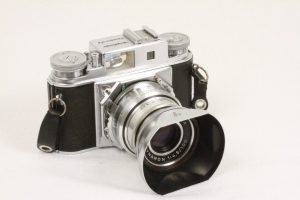
Despite this, in 1958 Voigtländer would produce a Prominent II which retained all of the original model’s features, but adding a significantly larger 1:1 viewfinder and rangefinder patch with integrated frame lines for 4 different focal lengths from 35mm to 150mm. The Prominent II would remain on sale until 1960.
Today, the Voigtländer Prominent is a bit of an enigma. Not nearly as sought after as anything made by Leitz, or even a nice Contax, but still worthy of adding to any collection. The build quality on these is very high, and they look outstanding. Although the lens mount was unique to this camera, many modern photographers will buy adapters to use Prominent lenses on digital mirrorless cameras as they produce extremely sharp and contrasty images. The camera’s themselves have ‘love it or hate it’ ergonomics, and depending on how you feel about them, might make them a must have, or a must pass.
My Thoughts
The Prominent was designed to compete with the best German rangefinder cameras of the 1950s. Although I used the plural of ‘cameras’ in that sentence, after the war, there were only two. Upon it’s release in 1952, you had the Zeiss-Ikon Contax III and the Leitz Leica II/III, and since the hugely updated M3 wouldn’t be available until 1954, at one time, the Voigtländer Prominent was the most advanced 35mm rangefinder camera Germany had to offer.
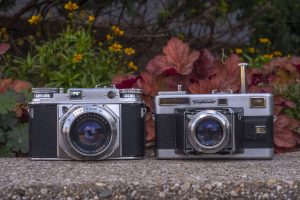
While it is still a highly desirable camera among collectors, the years since have not been kind to it’s legacy as used prices for Prominents are nowhere near that of the Leica M3. The reason for this is anyone’s guess, but I have to say that the ergonomics and control layout had to have played some part in that.
Voigtländer was never one to follow what other companies were doing. If Leitz was the Bill Gates of the camera industry, straight laced, by the books, motivated by making something that pleased everyone, Voigtländer was Steve Jobs, an eccentric company that made quality products their own way, eschewing the norms established by others.
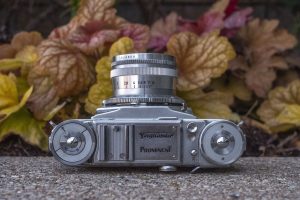
The top plate of the Prominent is pleasingly symmetrical featuring from left to right what looks to be a rewind knob, an accessory cold shoe, shutter release, shutter cable socket, rewind button, and film advance lever. I used the words “what looks to be” to describe the knob on the left, because although there is a flip up rewind knob there (more on that later), the entire thing is actually the focus knob for the lens.
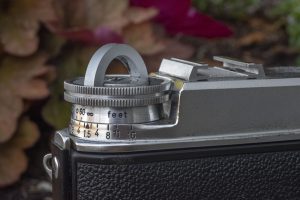
Focus knob you say? Yep! Voigtländer has put focus control on their cameras in non-standard locations before, but to my knowledge, the Prominent is the only camera where the focus is controlled by a large knob on the camera’s left side. It works easily enough, but it’s location makes holding the camera to your eye while changing focus rather awkward. I can only assume most people are like me and stabilize cameras with their left hand and naturally reach for some type of ring around the lens to change focus, but that’s not how it works here.
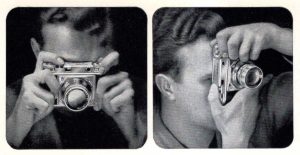
To be fair, many other cameras give your left hand something to do, such as the Ricoh 500 series with it’s bottom “trigger” film advance, or the Ihagee Exakta where the shutter release, wind lever, and shutter speed selector are all on the left, but save for the shutter release, each of those things can all be done prior to putting the camera to your eye, and with the Exakta’s shutter release, you can still comfortably grip the camera while firing the shutter. With the Prominent, I could never find a comfortable position where I could keep a steady grip on the camera with my left hand and easily change focus, without having to completely re-position my left hand. Look at the image to the right from the Prominent’s user manual showing how it’s done. Throughout the entire roll in this camera, I was constantly worried about dropping the camera with how often I had to keep moving my left hand while shooting it. This is definitely a camera you’d want to have attached to some type of strap while out and about to protect it in case you ever lose grip of it.
In the image above, you’ll also notice a metal arc that is flipped up, which acts as the rewind knob for when you reach the end of a roll of film. While looking down at the top of the camera, there is a little switch that you must push to get this arc to pop up. This was not obvious to me the first time I used this camera as I had to consult the manual to figure out how to rewind it.
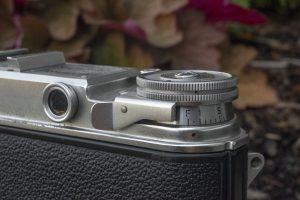
The other large knob is the film advance, or in the case of later Prominents a double wind lever, and beneath it, the exposure counter. The counter on the camera does not automatically reset, and must be done manually by pulling up on the knob and turning it until the red dot lines up with the “F” mark. Like most cameras not made by Kodak AG, the exposure counter counts upwards from 1 to 36.
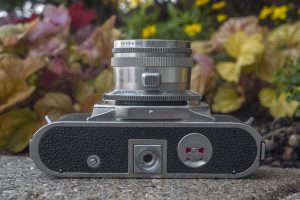
The bottom of the camera has a film transport indicator, the tripod socket, and a strange film remind disc that isn’t explained at all in the camera’s user manual. The tripod socket is integrated into the main body of the camera, rather than the film door, which adds strength to it.
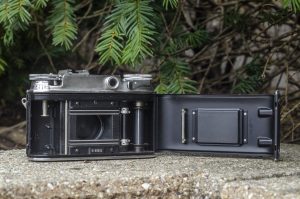
Loading film into the camera requires a simple pinch of two release buttons on the camera’s left side, and the right hinged door swings open for easy film loading. Film transport is from left to right, and the camera supports loading and unloading of partially exposed rolls. There is no film slicer like the one in the Ihagee Exakta, but behind the film advance lever is a transport release that allows you to easily rewind or advance a partially exposed roll without having to fire the shutter.
The viewfinder of the Prominent features a circular coincident image coupled rangefinder patch with multiple projected frame lines for 100mm and 50mm. Although there are no lines for 35mm, the entire frame roughly corresponds to a wide angle lens if you had one mounted. Although much smaller than the one in the Leica M3, it was a considerable improvement to the tiny ones in the Zeiss Contax and Barnack Leicas that this camera likely competed against. Normally I try to capture an image through the viewfinder to share with you, but it was so small that I couldn’t get my phone close enough to capture the whole image. The frame lines are extremely hard to see, even in person.
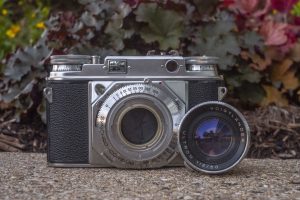
Featuring a bayonet lens mount unique to this camera (and it’s successor, the Prominent II), swapping lenses is easy. A simple press of a button at the 6 o’clock position of the lens and a quick twist in any direction and the lens comes off. To put it back on, there are no dots to line up, simply apply gentle press on the lens to the mount of the camera and twist until it locks into position. For all of the oddities in the Prominent’s design, this is one of the best features and something I wish more companies did. I only had access to the 50mm Ultron, so its plausible other lenses aren’t as easy, but I can’t say for sure.
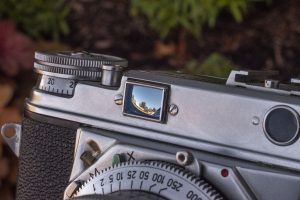
The Prominent has a self-timer feature, but it’s not obvious how to use it. In the image to the right, there is an arm sticking up out of the shutter (above the 250 indication on the shutter speed dial). When you advance the film to the next frame, a little lever will push this arm towards the red dot to the right of it. Once the shutter is set, you need to push this arm beyond the red dot until it stops. Once the arm locks into position beyond the red dot, the self timer is set and ready to countdown roughly 8 seconds the next time you press the shutter release.
Although I have reviewed a Leica M3, like this camera, it was a loaner so I did not have it handy to do a direct comparison. There is a ton of hype over the M3, and I tried to convince myself before I ever handled one that it wouldn’t live up to the hype, but I had a change of heart as it truly is a spectacular camera.
The Voigtländer Prominent is a really well built and neat camera. The fact that it’s NOT a Leica is actually one of my favorite things about it. Leica was so successful, that so many people copied their basic formula, and although you could argue that no one successfully matched the Leica M-series in design and functionality, the fact that so many people came very close, somewhat dilutes the shooting experience. Yeah, they’re wonderful cameras, but it’s so familiar to so many other cameras, once you pick one up and start using it, you forget that you’re using what it supposed to be a spectacular camera. The Prominent on the other hand is so odd in its design and execution, you’ll never forget what you have in your hands. So comparing an M3 to the Prominent isn’t really fair, but what could be fair are the types of images you can get from them.
My Results
As I do with most cameras for their inaugural roll, I loaded in a roll of Fuji 200 as I have a lot of experience with it, so I can differentiate between any concerns I might have from that caused by the film or the camera itself. This roll was shot in the summer of 2018 around the 4th of July.
This website averages between 800 and 1000 views a day. The way WordPress counts a view is by unique page hit, not by unique visitor. So if you come here, hit the main page, then click through 3-4 reviews, that counts as multiple views. I really have no idea how many unique visitors I get, but I am still happy with the numbers I see, as all of my traffic is accomplished entirely through Google searches and word of mouth.
With that in mind, I often wonder what are people’s favorite parts of my reviews? For cameras like the Prominent where there’s already a decent amount of information about them out there, I hope that you enjoy the History section about a model, or at least the My Thoughts section where I talk about using the camera and how it works.
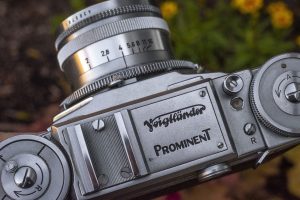
Maybe some of you really like seeing the images I get with these cameras. I know my eye is always caught by sample images in other people’s reviews, but I’ll fully admit that I know I’m not a very good photographer. When I am testing these cameras, I generally load up cheap film, and walk around with my kids, take them to a park, or just shoot random things I see on the side of the road or near where I work.
What I am trying to say is that the images I often share that I get with these cameras aren’t what most people would call “fine photography”. They’re just snapshots, and I wonder if on occasion I’m doing injustice to the cameras that I shoot them with. There is nothing fundamentally wrong with any of the images above, but they’re just random images of my life. I know the Ultron lens on the Prominent is fantastic lens and is highly regarded when adapted to digital, but when I look at them, to me they look like images shot by any other number of cameras I’ve shot. Is that a good thing, or a bad thing? I guess introspection is something I probably should tackle in another post.
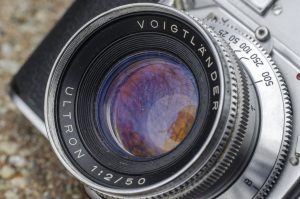
Maybe the quality of the images are somehow tied to my feelings and thoughts while using the camera that made them. I’ll confess that I didn’t love shooting the Prominent. The left handed focus wheel was too far out there for me and I never felt comfortable using it. I remember on many occasions nervously moving my hand back and forth from the focus knob and then back to a position where I could securely hold the camera.
I wear prescription glasses, and while the viewfinder and rangefinder patch was easy enough to see, I struggled to see the entire 50mm frame. I am also a left-eye shooter, and the eyepiece’s location closer to the right side of the camera always felt awkward to me.
I still like the Prominent. I have often given praise to cameras that are quirky or have characteristics about them that help them stand out from other cameras. This is a really well built camera with a lot of history and an awesome lens, I just didn’t love it. I wish I did, because it’s very pretty, but eventually this camera will go back to it’s rightful owner, and if I’m being honest with myself, I really won’t miss it.
Additional Resources
http://camerapedia.wikia.com/wiki/Voigtl%C3%A4nder_Prominent_I_%26_II
https://www.cameraquest.com/voiprom.htm
https://www.shutterbug.com/content/prominent
http://elekm.net/pages/cameras/prominent.htm
http://www.novacon.com.br/odditycameras/voigtland2.htm
http://www.ukcamera.com/classic_cameras/voigt2.htm
http://jitterypixel.blogspot.com/2016/06/the-voigtlander-prominent.html

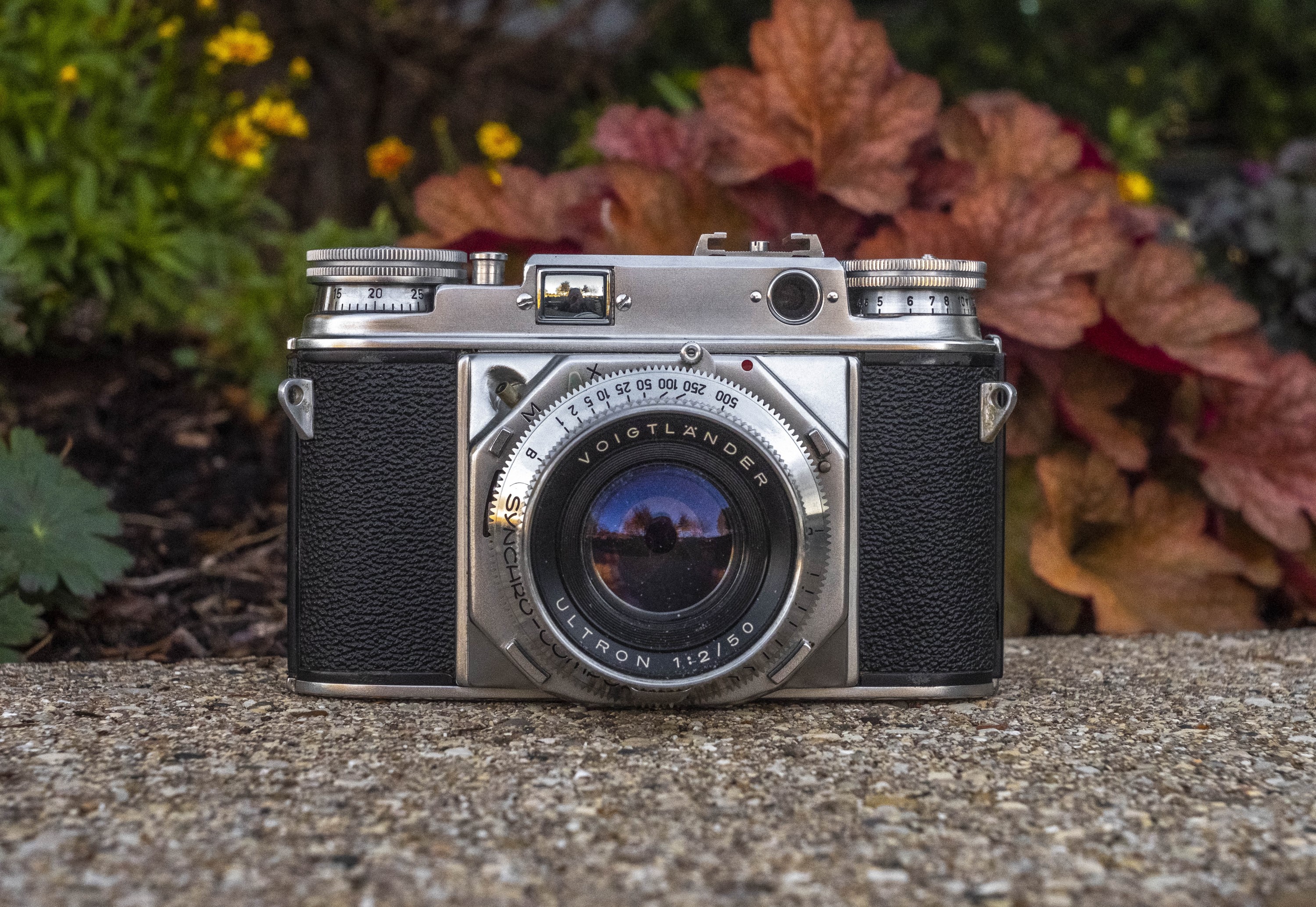
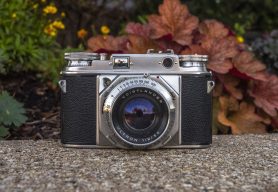
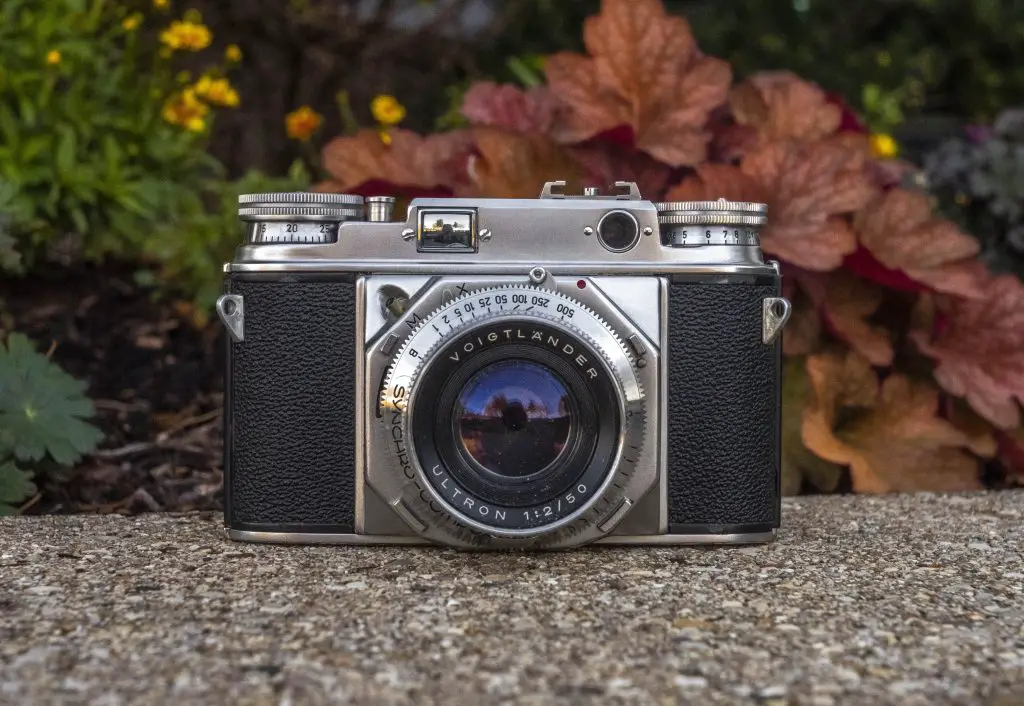


























On your review format: don’t change anything. I really like the history of these cameras and the tech descriptions. I really look closely at your sample photos too. It’s not the subjects that matter but the lens and camera performance I really am interested in.
Keep up the great work.
Jeff Oliveira
I need to add, that Voigtlander lens kicks butt. I have shot with Leica screwmount lenses for decades which are top quality and this lens is giving Leica a run for it’s money.
Ultragon was just a prototype. Second last model also had viewfinder with bright line frames & larger eyepiece
I concur with what Jeff said above. The format is just great, the history is very interesting to this camera geek (and many other proud geeks I suspect) and the pictures definitely tell a story about the lens and camera performance. Don’t change Mike, it’s just great as it is. It was also surprising to learn that I am not the only glasses-wearing, left eye using shooter on the planet.
My vision is terrible. I have been blind since birth in my right eye, so using my left eye is be necessity, not choice, and my left eye has a -9.25 prescription so I got some thick Coke bottles that I have to consider too! 🙂
I also really like your format as it is. I am very interested in the history behind the cameras and lenses I collect, and you tend to dig deeper than other reviewers. I have been collecting for many years and am likely old enough to be your Dad, but I learn something new almost every time I read one of your reviews. I also have poor vision, and I know if you have issues with a camera, I will too. On that note this review probably saved me a lot of money, I have been after one of these for years, bid on several, and always been outbid. After reading about the ergonomics, I’m sure I would never use it, and I only want cameras I will use. I have a couple of Voigtlanders and they kind o remind me of Puegeot cars, they never copied anybody else, and no one else copied them. Focus knob? No thanks.
Thanks for the kind words Jon!
I have always enjoyed history, whether its US history, the history of the automobile, or history of cameras. Thats why my “reviews” turn out to be more like essays than my actual opinions on the cameras themselves! 🙂
I’d had to tell someone who was interested in a particular model not to spend their money as what works for one person may not be for everyone, but yeah, if you have bad vision, you’re already at a disadvantage with this one. Of course, the Prominent II has a HUGE viewfinder, so maybe thats more suited to you.
The top plate focus knob was awkward, and one that I didnt get used to in the roll I shot, but I bet that if I stuck with it and shot repeated rolls, I would get used to it, but why force myself when I had other concerns with it! 🙂
It’s always great to hear from my readers, regardless of their age! 🙂 If theres ever anything you’d like to see reviewed, let me know, and I might have it in “the queue”. I have over 90 cameras that I am in the process of reviewing so you never know. And I accept donations if you have something you want to send to a new home! 🙂
I keep a display of about 35 cameras in my office. Basic box, folder, rangefinder and TLR cameras. Consequently, many who come to my office see the cameras and then on next visit drop off a camera or two they had. Mainly Pentax and Canon. However, one person dropped off a Prominent which immediately caught my attention. Spent the next hour trying to figure out how it worked. Every time I focused the lens it came off??? Finally found the knob up top and thought why? You are right in that the camera is beautiful and the build quality excellent.
I have had a Prominent body for several years, but not a lens. I purchased a Dynaron 100mm lens today, and will shoot with it soon. I’d be interested in other people’s experiences with this lens.
Mike, another well written and detailed post (on another of my favourite cameras). There is another camera that has the focus knob on the top left, the Rangefinder version of the Voigtländer Bessa, I found on both cameras that it didn’t take long to get used to the idea.
I believe the Vito III has the same top plate focus knob. I’ll acknowledge that with enough use, you could get used to any camera oddity. With the Prominent, it was a loaner, so I didn’t have the luxury of a long amount of time to keep shooting it. I found it frustrating enough in the first roll that even if I had more time, I wouldn’t have seen myself drawn back to it. Which is a shame because I normally like everything Voigtländer made! I think this is the only “less than stellar” review I’ve written on one of their products!
You consistently use “it’s” when you mean “its.” This slows down a reader. Please bone up on the proper uses of those two little words.
Thanks for the tip, Robert, but youve actually got it backwards. I usually use “its” when I really mean “it’s”. My high school typing teacher, Mrs. Ripley was never happy with my home row finger placement…
Mike what sort of a lens mount is this camera .I ask that as I see some lenses from this around that I could adapt to my mirrorless camera
The Prominent uses it’s own lens mount unique to this camera.
Hi Mike,
nice work, I do need some help here, I have a prominent II, do you know how to adjust the rangefinder horizontal?, mine can’t reach infinity, it looks different compare to the model I, any tips will be big help here, thanks
Hi Lee! I wish I could help you, but I have never so much as held a Prominent II. Many rangefinders have an adjustment screw behind a screw or port somewhere on the top or side of the camera. Sometimes it might even beneath the cold shoe. If you absolutely cannot find anything, then you’ll likely need to remove the entire top plate to adjust it. Good luck and if you figure it out, let us know, perhaps another reader will one day want to know the same thing.
Hi Mike, thanks for the reply, I opened the top cover and inside looks different to the Mode I, can’t find anything to adjust the rangefinder, hope someone can pass some information soon, thanks
I have a decent collection Prominent but only just found this page. Couple of thoughts
1. It’s vs. its. The possessive is ‘its’ without apostrophe because the contraction of ‘it is’ takes precedence. This causes much confusion. But it is a rigid rule of apostrophic usage.
2. There are generally claimed to be three basic types of the Prominent. The Type 27 is the original which is easily identified by the full width name plate and lack of accessory shoe. The shoe was a clip on locking into two studs, one front and one back, like the Bessa 6×9 folders. I suspect that they used the same shoe but I never use them as they tend to scratch the top plate.
The second type, the type 28 has a shortened name plate to make room for the fixed accessory shoe. The lenses were also upgraded cosmetically – the earlier lenses had a chrome dress ring, the later black. I have the Nokton and Ultron in chrome but not the Skopar.
The third body, the type 30 was sold as the Prominent II. It did not just have a lever wind upgrade as you state at one point but also the multiframe Albada finder. It is a VERY nice camera.
3. Lenses. There were two versions of the slower Skopar – an original f3.5 and a later f2.8. The papragraph here does confuse this a bit. Both areTessar types and given that, probably better at 3.5. These are rarer than the faster lenses as original users were professionals who opted for the better lenses. This they are a bit more collectible! As to quality I have a friend who was a photojournalist i Germany in the 1960’s-70’s. He used the Nokton on a Leica body in factory Leica mount. He probably wishes he’d kept it given the value now but there was a reason he preferred it to a Summilux.
4. Rear focussing. I’ve used a few with body focus. I much prefer the large left top knob to using the finger ring on a contemporary Contax/Nikon RF or strange others like a Fujica thumb focus wheel.
UPS delivered my Vöigtlander Prominent from Vienna today – got it from the Leica Classic store. With the 50mm 1.5 Nokton, 35mm Skopar and 100mm Dynaron. Now if there was a nice working Ultragon somewhere for sale, that might be added. This my third Vöigtlander camera, and really looking forward to taking this out and testing it out.
Nice to read and see that there are others who use it as well – definitely looks a peculiar camera and the focusing will take some time to get used to.
Hi,
Just a brief comment there is another camera that focuses with a knurled knob on the top left, that is the Ensign Commando. A folding coupled rangefinder with focus adjusted by moving the film plane ( like the Mamiya 6 which copied it).
Although unfortunately they didn’t fit it with the Xpres lens only the Ensar triplet.
Being a regular to Mike’s site, this one as admirable as are all of his articles.
Some nit-picking, though, if permitted:
The 50 mm Skopar to the Prominent was to arrive late and of a modest (or traditional) 1/3.5 aperture.
Whether this was due to budget considerations, or because this was intended as a particular lens for reproduction work, is open to discussion.
In my experience, while the 50 / 2.8 Skopar leaves nothing to be desired, the 1 / 3.5 formula turns out noticeably sharper. I have seen this with Vito and Vitessa cameras, which were offered equipped with either lens. The 1 / 3.5 pictures stand out (regardless of aperture used in the shot) in any galery side by side.
The saying goes, this applies to Zeiss’s Tessar accordingly. Indeed, a 50 / 3.5 Tessar was offered in the then contemporary, then new fat aluminum barrel for the Exakta, next to the ! / 2.8 and the true budget tiny Exa-Tessar. Anyway, I got myself one of these!
I like your brief review of early photographic history (as well as all your articles) but in this one there is an error: Eastman-Kodak did not invent flexible film. Dr. Goodwin invented it in the 1880’s, and his patent was acquired by Anthony and Scoville, precursors to Ansco. A lawsuit with Kodak confirmed / awarded Ansco. George Eastman simply stole and / or ignored the patent.